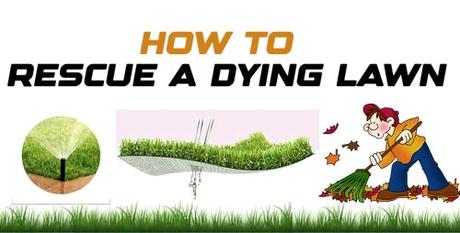
Putting your lawn on to the boulevard of charm and beauty is what you need to do as a gardener. It should be so much inciting that whoever sees this is mystified and perplexed with awe and veneration. It does not have anything to do with spending extravagantly on buying new stuff or renovation articles for lawn. The only thing it has to do with is taking its proper and due care. You should know the dos and don'ts of the lawn care. You will find this blog post a great help in your pocket for treatment and techniques you can adopt to renovate your lawn and bless it back with its lost glory. But before that an important step is to be considered.
Reason behind The Dead Lawn
Before going into the solutions, we should know the causes of the lawn's dryness. Determine what is irritating the lawn. Is it its clod or the pests? Does it need composting or is not aerated enough? Fix the problem by determining the actual cause, otherwise it will be a dead end. Find out the factors responsible for breaking your heart by damaging your lawn.
Consider the following things to defining the real problem
The Type of Turf- may be the turf you are using in the lawn is wrong one that does not go well with the soil.
Indecorous Cultural Rehearses- maybe you are doing everything for your lawn's health but ignoring a single one among the cultural practices will cost you a dime.
Disease and Plague- may be your lawn is suffering from a scourge. If yes eliminate it first.
Unprepared lawn - It is a possibility that your lawn is not well prepared for the harsh climatic conditions. Prepare it first. Tilling, weeding, watering, aerating and composting can build the soil's immunity to fight back the harsh circumstances.
Old grass - It is also a possibility that the grass in your lawn is destroyed to roots and needs a revival.
Rescue a Dying Lawn
Consider doing the following practices to ease the soil's poor condition and revitalize it to thrive.
Watering and irrigating is not always the answer. The lawns need something more than that. It needs fertilization, proper nutrients, pest killing, weeding, food and much more. The prior most thing that could be done to a dying lawn is composting. Compost will help your lawn get back to its feet with vigor and charm. For making it green we need to fertilize it properly and frequently. It is up to the gardener that either he chooses the organic compost or synthetic fertilizers. To gear up the green growth proper food should be provided in any form to the threatened lawn. If composting s not done properly, it can cost you a pretty penny.
So your lawn needs healthy solutions for its robust and stout condition.
The crystals of diluted magnesium sulphate- espom salt, is not only used as a purgative or for other medicinal use, can be used effectively in your lawn. Before the application of Epsom salt, determination of soil health is must. For this purpose conduct a soil test. If the result of your soil's pH turns out to be acidic rather than neutral at 7, there is a dire need to work for the soil amendment. You need to do it for the soil to get maximum of the nourishment. This is the time to go organic with the Epsom salt treatment. It is not a salt as its name shows but is a magnesium and sulfate compound that comes handy to repel and restrict vexations. You can apply it in both ways. Either you spread it out in your lawn with a spreader or hydrate it. By adding water to it, it will get in liquefied form which can be easily sprayed in the lawn using wand or sprayer. The results will please you beyond your belief and anticipations.
Is weed influx a constant threat to your yard and is darkening the charm of your yard that you have worked for all along? The weed incursion is the repercussion of inferior soil. But sometimes the finest of the soils also has weeds in it. We can save our lawn by any of the prominent methods of the weed killing. We can pull them out manually (if the weeds are feeble, fresh or young), pull them out with a weeder tool, or by using chemicals (for sturdy and well-established weeds). Stop for an instance do not opt for chemical sprays but rather try boiling water onto the weeds. It will damage the leaves and roots beyond measure and repair causing them to die naturally.
Why not to opt for mulching than raking the old leaves out of the lawn in the fall? Is protecting the lawn with something we consider trash a good idea? Yes, it is the best a gardener can do, recycling the dead leaves with mulching. So say no to rake and use the dead leaves for your lawn good for good. Spread the dead foliage as mulch like you do the bed sheet. Mown the lawn over and over again until the leaves become the size of a coin or less. They will putrefy and rot to provide not only a covering to the lawn but also augmenting it with the best organic and biological nutrients. So, it is killing two birds with one stone. Your dead leaves are no more a burden but golden fertilizers to you in the fall.
For the growth of your healthy grasses and lawn, the air water and the food should have easy and prompt access to the roots of the plants and grass. But building up of the thatch in your lawn is awful for its growth. Its build-up can impede the development of grass by overpowering the root system. Such a practice can divest the root system of the necessary nutrients, water and air. It should be nipped in the very beginning or else it will not only engulf the beauty of the lawn but will destroy everything associated with it by providing the pests with a favorable habitat. All you need to do is to reduce the thatch in the lawn by raking it every now and then. It will reduce the thatch pile up reducing its consequences to minimum.
Trimming is way too long a solution to avoid any noxious problem to the lawn. Giving it a trim will give it an attraction and joy to the onlooker's eyes. Cutting it too short will expose to the scorching heat of the sun making it dead and weak. Set your mower's height to highest possible level.
Aerating your lawn often can be a solution to many problems it suffers. Too much moving or walking in the lawn causes soil compaction. Consequently, the free air water and nutrition do not reach the roots affecting the lawn adversely. Soil compaction needs to be assuaged. To soften the soil aerate it quite often. For such a purpose an aerating machine could come handy. It unplugs the soil by alleviating it letting it to breathe. The food, water and the air will find a passage to access the roots. Walking and rain will help breaking down the soil plugs saving you from raking.
Grubs' influx can cause the damage to the grass roots. For combating grubs go to chemical spray. You will find many sprays to eliminate the vicious colonies of grubs that fade away the charm and charisma of your lawn. Ending them will put an end to the problems caused by them. Choose the chemical with less side effects and which is effective in a long run.
The nasty critters can be a source of misfortune for your yard. Mounds and hills in your lawn are sign of moles in your lawn. Be aware of this undercover threat- a problem has been detected in your yard. Trap the mole before it traps you. Look into the factors that attract moles and end them to discourage their frequent visits.

